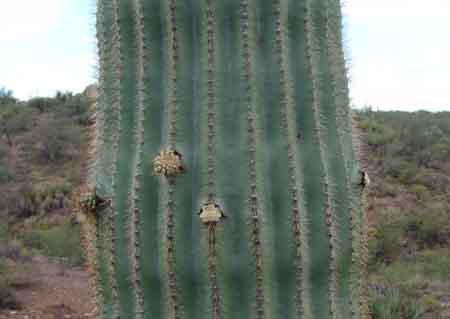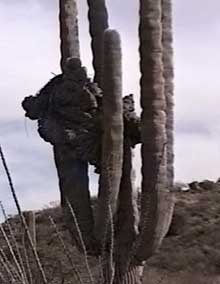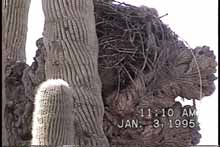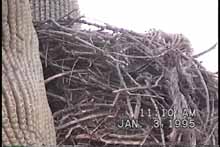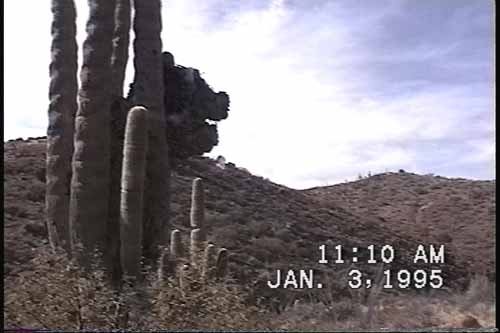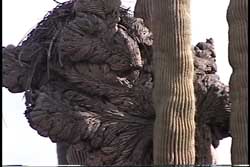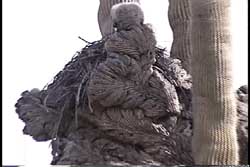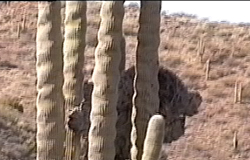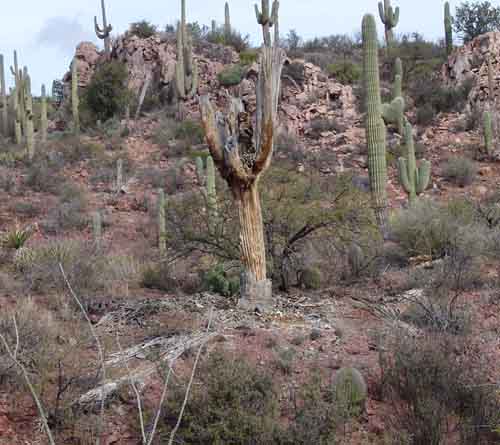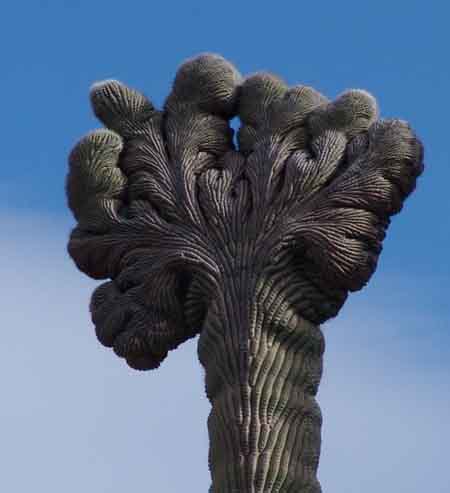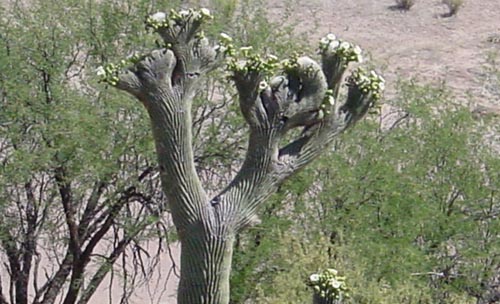Saguaro (Carnegiea gigantea)
Main Sources: Dimmitt, Mark, "Cactaceae", in Steven Phillips and Patricia Comus, eds., 2000, A Natural History of the Sonoran Desert, pp.84-93, Arizona-Sonora Desert Museum Press, Tucson; Crosswhite, Frank, 1980, "The annual saguaro harvest and crop cycle of the Papago, with reference to ecology and symbolism", Desert plants 2:1:3-62; Epple, Ann, 1995, A Field Guide to the Plants of Arizona, pp. 157-8, Lew Anne Publishing Co., Mesa AZ; Hodgson, Wendy, Food Plants of the Sonoran Desert.
 Our lands are remarkably rich in this largest, columnar cactus to be found in the United States. Young saguaros cannot survive either intense desert sunlight or trampling, so typically survivors begin growth under a "nurse" plant (palo verde, acacia, mesquite, creosote bush), growing about 1/2" in the first year and to 1' in about 15 years. (That its early vertical growth is slow is related to priority investment in expansion of the root system.) As the plant grows larger, its white-gray spines begin to provide protective shade for the trunk. In 40 to 50 years, saguaros reach about 10' tall (and first begin to flower and produce fruit), and in 75 to 100 years they may sprout arm buds, at heights of 12 to 20: here is a set just beginning to form, on a plant just north of the Trail Tank, seen in September 2004: (Click on the image below to see the whole plant.)
Our lands are remarkably rich in this largest, columnar cactus to be found in the United States. Young saguaros cannot survive either intense desert sunlight or trampling, so typically survivors begin growth under a "nurse" plant (palo verde, acacia, mesquite, creosote bush), growing about 1/2" in the first year and to 1' in about 15 years. (That its early vertical growth is slow is related to priority investment in expansion of the root system.) As the plant grows larger, its white-gray spines begin to provide protective shade for the trunk. In 40 to 50 years, saguaros reach about 10' tall (and first begin to flower and produce fruit), and in 75 to 100 years they may sprout arm buds, at heights of 12 to 20: here is a set just beginning to form, on a plant just north of the Trail Tank, seen in September 2004: (Click on the image below to see the whole plant.)
Saguaros may reach a height of 60', weigh as much as 9 tons, and reach ages of over 200 years (See below for some examples.).
The great upright stem of this cactus is strengthened by an interior cylinder of wooden "ribs". The pale green, columnar trunk has pleats which enable the plant to swell and shrink like an accordion depending on rains. A mature saguaro may soak up 200 gallons during a rainstorm, only gradually transpiring its supply over long periods of drought (see images below). It can tolerate cold to below freezing, provided the duration of such temperatures is brief -- less than 24 hours. (This explains why most saguaros in our area are found on south-facing slopes, and why around 4,000' elevation is its upper limit in our area. The northern- and higher-elevation-limits of this temperature constraint marks the limits of our Sonoran Desert, as set by the distribution of this plant.) Saguaros grow to maturity best on sloping, coarse soils, since their roots require good drainage and soil aeration.
The skin of a saguaro is covered with a thick, waxy cuticle which waterproofs the surface and restricts water vapor loss to the stomates (pores provided for gas exchange). The pleats have areoles, roundish pads distributed about 1" apart and from which the spines (8-30 per areole) protrude. Spines are important not only for defense from herbivores but also for shading, thus cooling the trunk.
Immediately beneath the skin is a thin layer of chlorophyll-containing cells which do most of the photosynthesis for the plant. Most of the plant's bulk is water storage tissue (which also prevents overheating -- it absorbs heat during the day and releases it at night). The root system is shallow (aside from one tap root extending more than 2' down), but it radiates out about as far as the plant is tall, and thus eventually robs its nurse plant of moisture, eventually killing it. Growth of the above-ground plant accelerates over time, as its roots are able to absorb moisture from the briefest and lightest of rains.
Botanists formerly thought that the presence of extensive stands of Saguaros only of a particular age was evidence of some kind of regional climatic, disease- or human-caused change -- for example, the presence of only old Saguaros in an area of Saguaro National Park reflected a long-term decline of the plant in that area. But more recent evidence suggests that Saguaro seeds germinate and survive in considerable numbers rather rarely, only after unusually propitious weather conditions facilitate this in particular locales. As Dimmitt (p. 188) suggests, such survival requires "several consecutive years of milder and wetter-than-average weather", conditions which occur in the various parts of the Arizona Uplands "only a few times a century."
In parts of Saguaro Juniper and continguous lands, we have large numbers of rather young Saguaros, indeed on one small terrace in Lower Hot Springs Canyon one can see groupings (of six, nine, and a baker's dozen respectively) of very small plants rising up protected underneath three different nurse trees. See below for a view of 13 young saguaros under a Palo Verde. While this profusion may indeed reflect a gradual spreading of Saguaros into our area, it more definitely points to a recent period of propitious rainfall at this particular location.
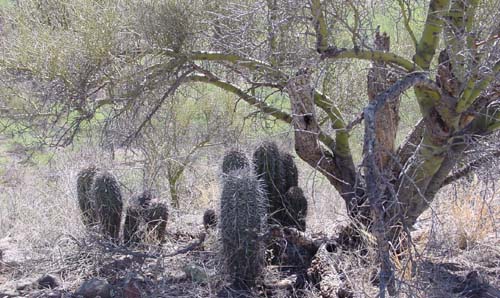
In another location (a wash slope of Soza Mesa), we see a situation where a large saguaro has grown to dwarf its former nurse, and has also spawned a next-generation nursling: (click on the image for a closeup of the plant's base)
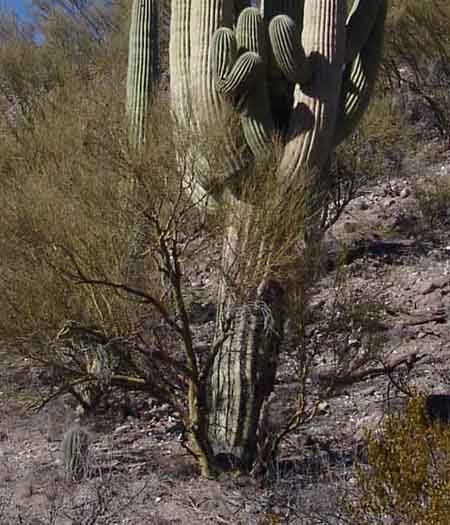
Only when saguaro plants first germinate do they have leaves, as shown in this photo where the tiny sprouts are compared in size to a Lincoln penny. Click on the image to enlarge it.
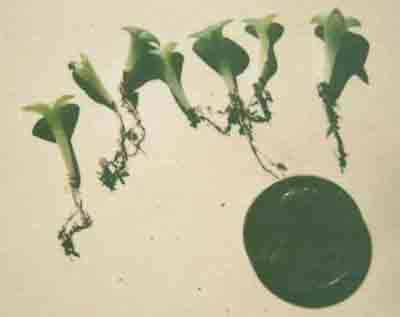
The seedlings are extremely vulnerable at first, and only those protected by nurse plants (which provide shelter and protection from herbivores -- from mice to birds) are likely to survive. Growth rate is very slow at first, plants attaining perhaps 1 1/2 inches in height after 10 years, perhaps 2 feet tall in 30 years. Saguaros begin to flower in our area between 40 and 50 years, when they are around 8 feet tall (Dimmitt, p. 188).
Waxy-white and funnel-shaped flowers bloom in May to June, opening at night (this is a plant of the Cereus family) and remaining open part of the following day (each individual flower blooming for only one day). A mature plant may produce 200 flowers per year, a few opening each day. Bats and moths pollinate them at night, diverse insects by day. The Cactus Bees appear to be crucial pollinators in our area. The ovate, green fruits split open in late June and July, revealing their deep-red pulpy interiors, each fruit containing up to 2,000 tiny black seeds. A wide variety of creatures including humans enjoy the sweet pulp, seeds, and juice.
See Saguaro fruit & processing for an account of the ripened fruit, its harvesting and processing, and review of the importance (both historical and contemporary) of saguaro fruit as a foodstuff.
In the photos at below right, the bloom has been split to show the interior structure: at the base, the ovary (which becomes the fruit), the central pistil, and the many stamens and petals surrounding it in radial symmetry. This is the most ancient type of flower form. Click on the three right-hand images to enlarge.
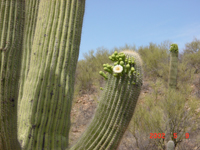
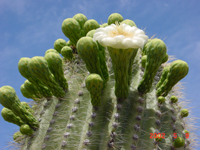
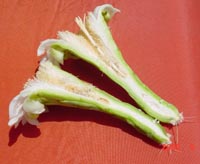
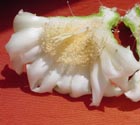
Here (below) is a comparison of the Rabbit Ears Saguaro, located atop the hill of that name in Hot Springs Canyon, taken in 1993 and again in 2002. The growth of all four arms has been very considerable during the 9 year interval. In the June 1993 photo at left, the saguaro has almost completed its blooming, while in the May 2002 photo at right the blooms are just beginning. In June 1993 the plant was fairly full of water, while in May 2002 it shows the slendering effects of a long, almost unbroken winter drought. (The plant on the right will have a rich blossoming and harvest despite this drought, since the effects of the immediately prior rainfall become apparent in fruiting only after a year has passed. A wet spring will be directly followed by a relatively poor harvest, as happened in the spring of 2004.)
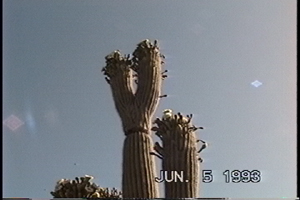
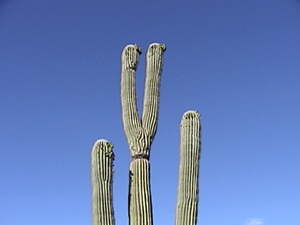
Here is a photo of the largest Saguaro we have seen in our area. (Let us know if you've seen a larger one!) It is located beside the Cascabel road just downhill from the Cascabel Community Center (the clerestory windows of which are visible behind this huge tree):
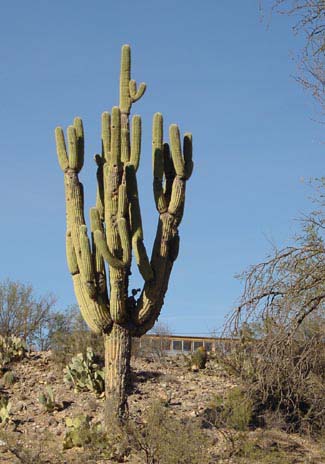
Patterns of growth and decline
The images below -- of a multi-armed Saguaro which fell sometime during the rains of late 2001 -- illustrate the shallowness (though not the spread -- many small roots broke off under the strain of collapse) of the root system:
Click on left-below image to enlarge.
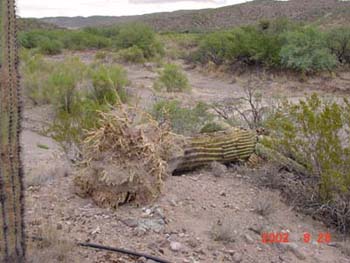
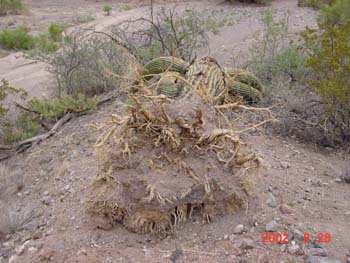
Collapses of this kind are almost always caused by a combination of wind and rain (when the root-holding ground has been softened by water and wind-gusts have been unusually strong) and usually destroy multi-armed saguaros rather than single-stalk plants (because the multi-armed trees display both greater top-heaviness and larger wind-catching surfaces). However, multiple arms in a mature saguaro also generate greater quantities of fruit production than are available to a single-stalked tree of similar height, a fact that apparently compensates for this greater structural vulnerability of size.
On the other hand, many saguaros in our area die abruptly when struck by lightning, a fate which generally leaves the trunk standing. Here are two examples, on the left, near the Red Tank in August of 2003, soon after a thunderstorm, and on the right, near the High Tank, photographed in April of 2004 (long after the event -- we are not entirely sure of the cause of this collapse): (Click on the left image to enlarge it.)
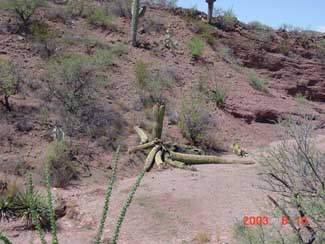
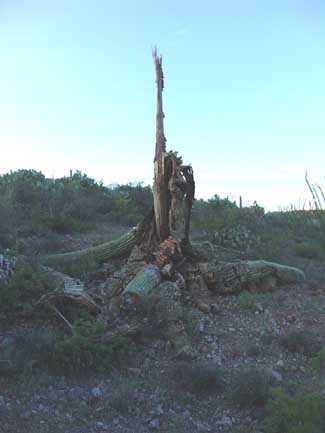
Saguaros are prey to a variety of ills besides bad weather. For more discussion (and images) of Saguaro ailments, decline and demise, see this link: Saguaro Ailments, Death & Decay.
Since 2002, Saguaro Juniper has joined with the Earlham Southwest Field Studies division of Earlham College (Richmond, Indiana) to conduct a census of a particular saguaro population in Hot Springs Canyon. For more details on the progress and results of this ongoing research, see the following link:
Saguaro Census in Hot Springs Canyon 2002-2006
Cristate (crested) forms
From unknown causes, occasionally saguaros develop a disorganized growth pattern in which the growing point spreads into a line of dividing cells, producing a fan-shaped tip. The causes of this altered growth pattern are unknown, but it does not appear to damage the health of the plant significantly. The following are some examples of these "cristate" forms.
A short distance up-wash from Upper Cottonwood Seep, on a low ridge stands a striking cristate saguaro. Here are views of it from January 1995:
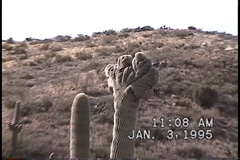
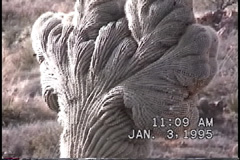
Near to it, in 1995, stood a much more unusual cristate type:

